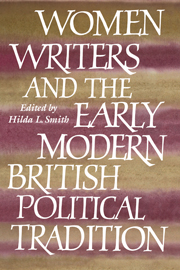Book contents
- Frontmatter
- Contents
- List of contributors
- Preface
- Introduction: Women, intellect, and politics: their intersection in seventeenth-century England
- Part I Women's political writings, 1400–1690
- Introduction to Part I
- 1 Christine de Pizan and the origins of peace theory
- 2 Political thought/political action: Margaret Cavendish's Hobbesian dilemma
- 3 Women's public political voice in England: 1640–1740
- 4 Contextualizing Aphra Behn: plays, politics, and party, 1679–1689
- Part II Women's political and philosophical writings, 1690–1800
- Part III The intellectual context and economic setting for early modern women
- Part IV Early modern legal and political prescriptions for women
- Conclusion: women's writing, women's standing: theory and politics in the early modern period
- Index
3 - Women's public political voice in England: 1640–1740
from Part I - Women's political writings, 1400–1690
Published online by Cambridge University Press: 04 August 2010
- Frontmatter
- Contents
- List of contributors
- Preface
- Introduction: Women, intellect, and politics: their intersection in seventeenth-century England
- Part I Women's political writings, 1400–1690
- Introduction to Part I
- 1 Christine de Pizan and the origins of peace theory
- 2 Political thought/political action: Margaret Cavendish's Hobbesian dilemma
- 3 Women's public political voice in England: 1640–1740
- 4 Contextualizing Aphra Behn: plays, politics, and party, 1679–1689
- Part II Women's political and philosophical writings, 1690–1800
- Part III The intellectual context and economic setting for early modern women
- Part IV Early modern legal and political prescriptions for women
- Conclusion: women's writing, women's standing: theory and politics in the early modern period
- Index
Summary
It is the “usual work of women either to spin or knit, not to meddle with State Affairs,” observed a commentator in mid-seventeenth-century England. Echoing the point later in the century a writer inquired of his readers: “Do you not think Learning and Politicks become a Woman as ill as riding astride?” These two remarks, themselves typical of many others, express the prevailing view of women in politics in early modern England. This view (although sometimes contested) held that women were not supposed to have a public voice, much less a public political voice. Nonetheless, starting in the 1640s and lasting to the mid-eighteenth century when their voices faded and their public role receded, a growing number of middle- and lower middle-class women in England (as distinct from aristocratic women, who had long exercised private political influence) did “meddle with State Affairs.” Their “meddling” took various forms, none more important than that of printing their ideas on a variety of political, religious, administrative, social, and economic issues. For women the very act of using the printing press was of great significance. It was symbolic – a public defiance of traditional norms; in practical terms, it empowered women as nothing else had ever done, enabling them to make their ideas public, somewhat permanent, and available to a wider audience than would otherwise have been possible.
- Type
- Chapter
- Information
- Publisher: Cambridge University PressPrint publication year: 1998
- 4
- Cited by



